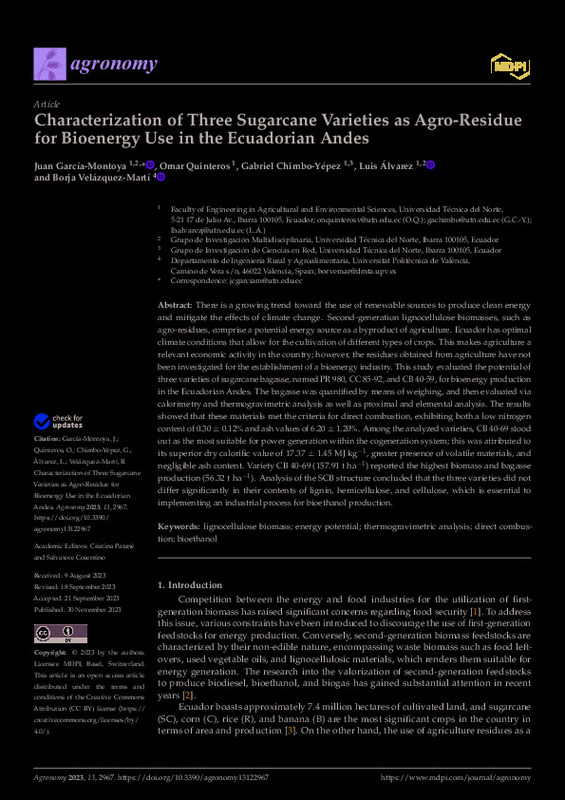JavaScript is disabled for your browser. Some features of this site may not work without it.
Buscar en RiuNet
Listar
Mi cuenta
Estadísticas
Ayuda RiuNet
Admin. UPV
Characterization of Three Sugarcane Varieties as Agro-Residue for Bioenergy Use in the Ecuadorian Andes
Mostrar el registro sencillo del ítem
Ficheros en el ítem
| dc.contributor.author | Garcia Montoya, Juan
|
es_ES |
| dc.contributor.author | Quinteros, Omar
|
es_ES |
| dc.contributor.author | Chimbo-Yépez, Gabriel
|
es_ES |
| dc.contributor.author | Álvarez, Luís
|
es_ES |
| dc.contributor.author | Velázquez Martí, Borja
|
es_ES |
| dc.date.accessioned | 2024-04-11T07:22:21Z | |
| dc.date.available | 2024-04-11T07:22:21Z | |
| dc.date.issued | 2023-12 | es_ES |
| dc.identifier.uri | http://hdl.handle.net/10251/203301 | |
| dc.description.abstract | [EN] There is a growing trend toward the use of renewable sources to produce clean energy and mitigate the effects of climate change. Second-generation lignocellulose biomasses, such as agro-residues, comprise a potential energy source as a byproduct of agriculture. Ecuador has optimal climate conditions that allow for the cultivation of different types of crops. This makes agriculture a relevant economic activity in the country; however, the residues obtained from agriculture have not been investigated for the establishment of a bioenergy industry. This study evaluated the potential of three varieties of sugarcane bagasse, named PR 980, CC 85-92, and CB 40-59, for bioenergy production in the Ecuadorian Andes. The bagasse was quantified by means of weighing, and then evaluated via calorimetry and thermogravimetric analysis as well as proximal and elemental analysis. The results showed that these materials met the criteria for direct combustion, exhibiting both a low nitrogen content of 0.30 +/- 0.12% and ash values of 6.20 +/- 1.20%. Among the analyzed varieties, CB 40-69 stood out as the most suitable for power generation within the cogeneration system; this was attributed to its superior dry calorific value of 17.37 +/- 1.45 MJ kg-1, greater presence of volatile materials, and negligible ash content. Variety CB 40-69 (157.91 t ha-1) reported the highest biomass and bagasse production (56.32 t ha-1). Analysis of the SCB structure concluded that the three varieties did not differ significantly in their contents of lignin, hemicellulose, and cellulose, which is essential to implementing an industrial process for bioethanol production. | es_ES |
| dc.language | Inglés | es_ES |
| dc.publisher | MDPI | es_ES |
| dc.relation.ispartof | Agronomy | es_ES |
| dc.rights | Reconocimiento (by) | es_ES |
| dc.subject | Lignocellulose biomass | es_ES |
| dc.subject | Energy potential | es_ES |
| dc.subject | Thermogravimetric analysis | es_ES |
| dc.subject | Direct combustion | es_ES |
| dc.subject | Bioethanol | es_ES |
| dc.subject.classification | INGENIERIA AGROFORESTAL | es_ES |
| dc.title | Characterization of Three Sugarcane Varieties as Agro-Residue for Bioenergy Use in the Ecuadorian Andes | es_ES |
| dc.type | Artículo | es_ES |
| dc.identifier.doi | 10.3390/agronomy13122967 | es_ES |
| dc.rights.accessRights | Abierto | es_ES |
| dc.contributor.affiliation | Universitat Politècnica de València. Escuela Técnica Superior de Ingeniería Agronómica y del Medio Natural - Escola Tècnica Superior d'Enginyeria Agronòmica i del Medi Natural | es_ES |
| dc.description.bibliographicCitation | Garcia Montoya, J.; Quinteros, O.; Chimbo-Yépez, G.; Álvarez, L.; Velázquez Martí, B. (2023). Characterization of Three Sugarcane Varieties as Agro-Residue for Bioenergy Use in the Ecuadorian Andes. Agronomy. 13(12). https://doi.org/10.3390/agronomy13122967 | es_ES |
| dc.description.accrualMethod | S | es_ES |
| dc.relation.publisherversion | https://doi.org/10.3390/agronomy13122967 | es_ES |
| dc.type.version | info:eu-repo/semantics/publishedVersion | es_ES |
| dc.description.volume | 13 | es_ES |
| dc.description.issue | 12 | es_ES |
| dc.identifier.eissn | 2073-4395 | es_ES |
| dc.relation.pasarela | S\504747 | es_ES |








